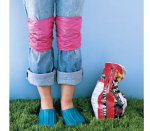
Image via Wikipedia
Reasons to Avoid Plastics
They’re made from petroleum, a non-renewable resource.
Production of plastics releases toxic chemicals into the environment.
Chemicals can migrate from many plastics into food, water, air and our mouths.
How to Avoid Using Plastics
Bring cloth totes or string bags to your supermarket to carry groceries home.
Choose refillable, reusable containers made of glass, ceramic or stainless steel.
Choose packaging that’s made from the most easily recyclable materials: paper, glass, metal cans.
Bring your own container to salad bars, delis, wherever they serve in plastic.
For wrapped foods, best choices are butcher paper, waxed paper or wood-based cellulose bags (available from Seventh Generation).
Avoid single-use, disposable packaging. Buy in bulk, the least-packaged option.
Microwave foods and drinks in oven-proof glass or ceramic. Never let plastic wrap touch food while in the microwave.
Avoid plastic cutlery and dinnerware. Use metal utensils and look for recycled paper plates.
Safer, Sounder Plastics to Choose
When plastic cannot be avoided, check container bottoms for recycling codes (in triangle) and choose those that are accepted for recycling in your area. The most commonly recycled plastics are #1 (PETE) or #2 (HDPE).
Choose non-PVC cling wrap (such as Glad and Handiwrap).
Plastics to Avoid
Steer clear of PVC vinyl (#3) whose manufacture and incineration releases carcinogenic dioxins into the environment and food chain. PVC often contains lead, and toxic plasticizers such as phthlates that can migrate into food, water, air and our mouths.
Avoid plastics that are often not recyclable: #3 (PVC), #4 (LDPE), #5 (PP), #6 (PS), #7 (“Other,” often polycarbonate).
Avoid plastics that leach chemicals suspected of disrupting hormone functions: #3 (PVC), #6 (PS), #7 (often polycarbonate, other varieties of plastic labeled #7 are regarded as safe).
http://www.thegreenguide.com/home-garden/recycling/reduce-plastics
31.248372
-85.375625






 First things first, a little R & R & R
First things first, a little R & R & R







